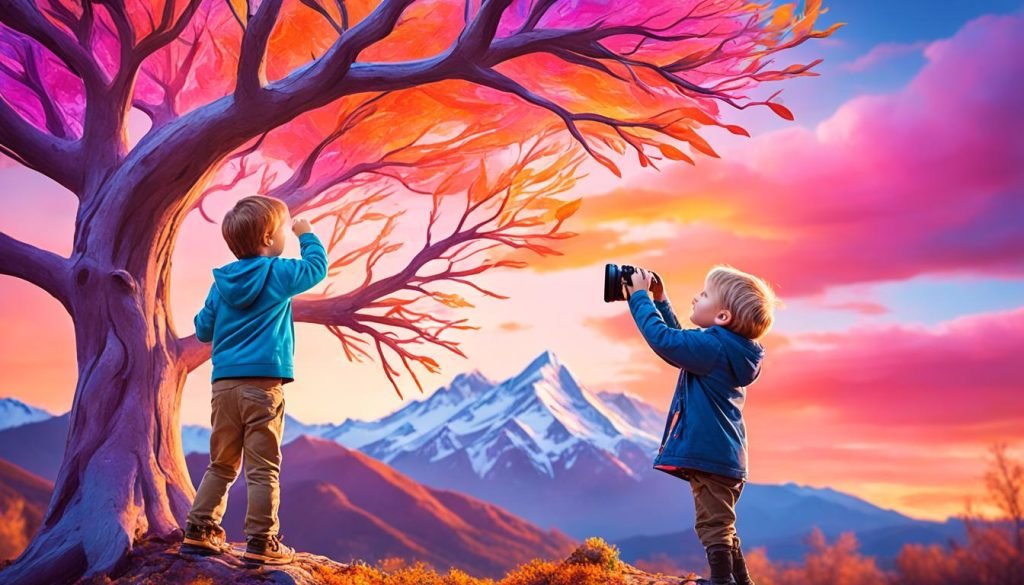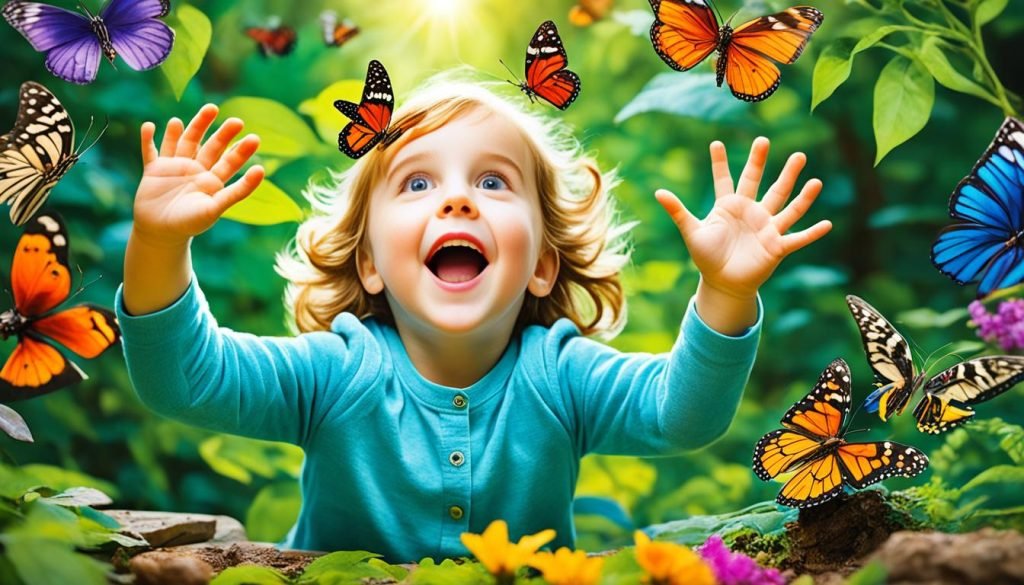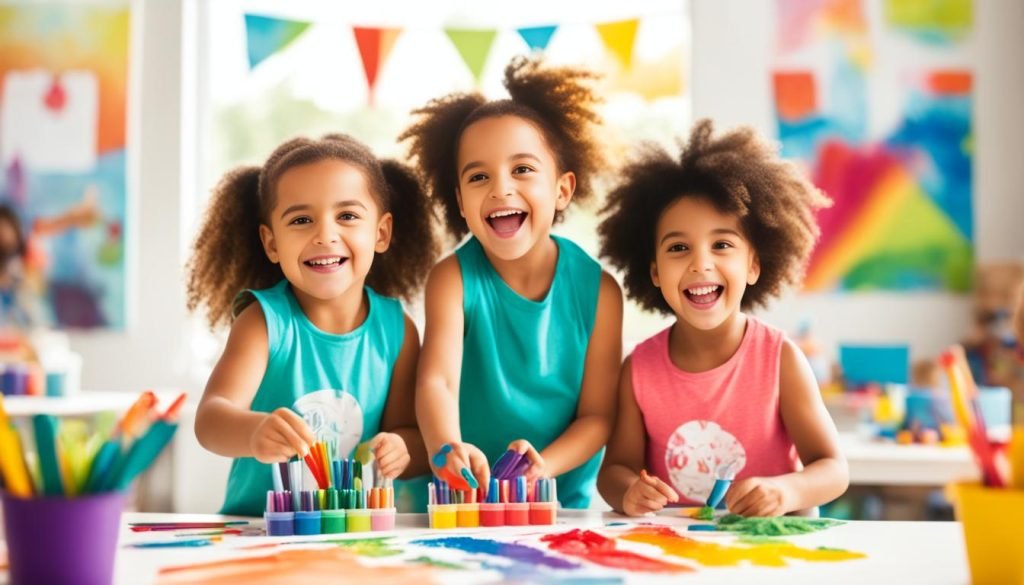Unlock your child’s boundless creativity with expert tips on nurturing creative talent from childhood. Inspire imagination and foster artistic expression. Creative talent can be nurtured from a young age through various strategies that engage children’s natural curiosity and spark their imaginations. This article will explore effective methods for parents and teachers to cultivate creativity, innovation, and artistic potential in young minds.
Key Takeaways
- Discover proven strategies to unlock your child’s creative potential
- Learn how to inspire imagination and foster artistic expression
- Explore effective techniques to cultivate creativity and innovation
- Uncover the secrets to nurturing creative talent from a young age
- Empower parents and teachers to unlock the boundless potential of young minds
Understanding the Importance of Nurturing Creativity
Creativity is a vital skill that allows children to explore their individuality, problem-solve, and express themselves. Nurturing creativity from an early age helps foster imagination and develop artistic talents, ultimately cultivating innovative thinking. When children are encouraged to think outside the box, they are better positioned to unlock their full potential and become confident, adaptable, and successful individuals.
Fostering Imagination and Artistic Expression
Providing opportunities for creative exploration and self-expression is essential for children’s cognitive, emotional, and social development. By nurturing their imagination and encouraging artistic expression, we can empower young minds to discover their unique talents and embrace the joy of creative pursuits.
Cultivating Innovation and Unlocking Potential
When children are given the freedom to think innovatively and explore their creative potential, they develop the skills and mindset necessary to thrive in an ever-evolving world. By fostering an environment that supports imagination and creative problem-solving, we can unlock the boundless potential of our youth and inspire them to become the innovative thinkers and visionaries of the future.
The Role of Parents and Teachers
Parents and teachers play a pivotal role in nurturing creative talent in young minds. By encouraging originality and fostering a creative mindset, they can empower children to develop their artistic vision and spark their innate creativity. Through positive reinforcement, open-ended questioning, and exposure to diverse experiences, adults can help children overcome fears, embrace mistakes, and take risks in their creative pursuits.
Encouraging Originality and Developing a Creative Mindset
One of the key responsibilities of parents and teachers is to encourage originality and help children develop a creative mindset. This can be achieved by fostering an environment that celebrates self-expression, values individuality, and provides ample opportunities for children to explore their interests and ideas. By nurturing a growth mindset that embraces challenges and views mistakes as learning opportunities, adults can instill the confidence and resilience necessary for children to thrive as innovative thinkers and artists.
Empowering Artistic Vision and Sparking Creativity
Alongside encouraging originality, parents and teachers play a crucial role in empowering children’s artistic vision and sparking their innate creativity. By exposing children to a diverse range of artistic mediums, cultural experiences, and creative problem-solving activities, adults can help broaden their horizons and inspire them to explore new avenues of self-expression. Providing positive feedback, recognizing their unique talents, and displaying their creative works can further boost children’s self-confidence and motivate them to continue on their creative journeys.

Ultimately, the role of parents and teachers in nurturing creative talent is vital. By cultivating a supportive environment, encouraging originality, and empowering artistic vision, they can unlock the boundless potential of young minds and set them on a path to becoming confident, innovative, and self-expressive individuals.
Creating an Environment for Creative Growth
Establishing an environment that nurtures creative growth is essential for children’s development. By allowing for unstructured play and exploration, we can encourage them to tap into their imagination, problem-solve, and uncover new ideas. Providing access to a diverse array of creative resources and materials, such as art supplies, building blocks, and open-ended toys, further stimulates their creativity and enables them to experiment with different mediums.
Allowing Unstructured Play and Exploration
Unstructured play and exploration are crucial for fostering a child’s creative potential. When given the freedom to engage in imaginative and hands-on activities, children can develop their problem-solving skills, discover their unique interests, and cultivate a sense of autonomous learning. By creating spaces and opportunities for this type of free-flowing exploration, parents and teachers can cultivate an environment that promotes creative expression and innovation.
Providing Creative Resources and Materials
Offering a wide range of creative resources and materials can significantly stimulate a child’s creativity. From art supplies like paints, brushes, and clay to open-ended toys like building blocks, puzzles, and dress-up clothes, these tools allow children to experiment, manipulate, and bring their ideas to life. By providing access to a diverse array of creative mediums, we can empower children to explore their interests, develop new skills, and push the boundaries of their own creative abilities.
Nurturing Creative Talent
Nurturing creative talent in young minds is a multifaceted endeavor that requires a comprehensive approach. From encouraging unstructured play and exposing children to new experiences, to celebrating their creative expression and empowering their artistic vision, the process of nurturing creativity is an ongoing journey that involves the active participation of both parents and teachers.
By fostering an environment that supports imagination, risk-taking, and self-discovery, we can unlock the boundless potential of young minds and set them on a path to becoming confident, innovative, and self-expressive individuals. The key to nurturing creative talent lies in creating a supportive and enriching ecosystem that caters to the unique needs and interests of each child.
| Strategies for Nurturing Creative Talent | Benefits |
|---|---|
| Encouraging unstructured play and exploration | Allows children to use their imagination, problem-solve, and discover new ideas |
| Exposing children to diverse experiences and new activities | Expands their horizons, sparks curiosity, and inspires creative expression |
| Celebrating and sharing children’s creative works | Boosts self-esteem, fosters a sense of accomplishment, and contributes to a culture of creativity |
| Empowering artistic voice and individuality | Develops confidence, nurtures self-expression, and cultivates innovative thinking |
By embracing this multifaceted approach, we can create an environment that nurtures the creative talent of young minds and sets them on a path to personal fulfillment and success. This journey of nurturing creativity is an investment in the future, empowering the next generation of creative thinkers, problem-solvers, and visionaries.

Engaging in Imaginative Play and Activities
Fostering creativity in young minds is essential, and one powerful way to nurture this important trait is by engaging children in imaginative play and activities. By modeling creativity and imaginative thinking, parents and teachers can inspire children to explore their own ideas and embrace the joy of self-expression.
Modeling Creativity and Imaginative Thinking
When adults demonstrate their own creative process, whether through storytelling, art projects, or problem-solving, they provide children with valuable examples of how to approach challenges with an open and innovative mindset. This modeling encourages kids to think outside the box, experiment with new ideas, and find unique solutions to the tasks they encounter.
Stimulating Kids’ Imaginations
Activities such as role-playing, open-ended art projects, and collaborative storytelling can significantly stimulate children’s imaginations. These types of activities allow kids to tap into their innate creativity, express themselves freely, and develop the essential skills needed to become innovative problem-solvers and creative thinkers. By providing children with the freedom to explore their interests and push the boundaries of their creativity, we can help them build the confidence and resilience necessary to thrive in an ever-evolving world.
Exposing Children to New Ideas and Experiences
Nurturing the creative talents of young minds requires exposing them to a diverse range of new ideas and new experiences. By introducing children to new activities and art mediums, we can open up a world of creative exploration and unlock their boundless potential.
Introducing New Activities and Art Mediums
From music and dance to various visual arts, providing children with the opportunity to experiment with different creative art mediums can ignite their imaginations and foster a deeper appreciation for self-expression. Whether it’s painting, sculpting, or even coding, the act of engaging in new activities encourages children to think outside the box and approach problem-solving in innovative ways.
Exploring Different Cultures and Perspectives
Expanding children’s understanding of the world by exposing them to different cultures and perspectives can also have a profound impact on their creative development. Through books, films, or immersive cultural experiences, children can gain a deeper appreciation for diverse ways of thinking and problem-solving. This exposure not only broadens their horizons but also inspires them to approach challenges and self-expression with a fresh, creative lens.

By nurturing children’s natural curiosity and encouraging them to explore new ideas and experiences beyond their own, we can empower them to become innovative thinkers, problem-solvers, and artists who are equipped to thrive in an ever-changing world.
Fostering Curiosity and Asking Questions
Nurturing creativity in young minds starts with fostering a sense of curiosity and encouraging children to ask questions. By promoting open-ended thinking and problem-solving, we can empower them to explore, experiment, and find unique solutions to challenges. This approach not only sparks their imagination but also develops the critical thinking skills necessary for success in an ever-changing world.
Encouraging Open-Ended Thinking and Problem-Solving
Rather than providing predetermined answers, we should guide children to ask thought-provoking questions and engage in open-ended discussions. This allows them to think creatively, consider multiple perspectives, and develop the ability to tackle complex problems. By fostering an environment where ideas are freely exchanged and solutions are collaboratively sought, we nurture the problem-solving capabilities that are so vital for the future.
Embracing Mistakes as Learning Opportunities
Embracing mistakes as learning opportunities is crucial for cultivating creativity. When children feel safe to take risks and explore their ideas without fear of failure, they are more likely to develop resilience and the confidence to push the boundaries of their own creativity. By shifting the focus from perfection to the process of learning, we can help children understand that mistakes are not obstacles but rather stepping stones to growth and innovation.

Celebrating and Encouraging Creative Expression
Celebrating and encouraging children’s creative expression is essential for nurturing their talent and fostering their self-confidence. Providing positive feedback and reinforcement, such as acknowledging their efforts and highlighting their unique strengths, helps children feel valued and empowered to continue exploring their creativity.
Providing Positive Feedback and Reinforcement
When we celebrate and encourage children’s creative works, we send a powerful message that their unique talents and self-expression are appreciated. This positive reinforcement can have a profound impact on their self-esteem, motivating them to continue pursuing their artistic passions.
Displaying and Sharing Children’s Creative Works
Displaying and sharing children’s creative works, whether through art exhibits, performances, or online platforms, not only boosts their self-esteem but also inspires others and contributes to a culture of creativity within the community. By recognizing and celebrating the diverse ways in which children express their creativity, we can cultivate a supportive environment that fosters their artistic growth and development.

Nurturing Self-Expression and Confidence
Nurturing self-expression and confidence is the cornerstone of empowering children to thrive as creative individuals. By embracing and nurturing their self-expression, we can help them develop the self-assurance and resilience necessary to take creative risks and overcome challenges with confidence.
Empowering Artistic Voice and Individuality
When children feel secure in their ability to express themselves authentically and explore their unique individuality, they are more likely to embrace their creative potential and find fulfillment in their artistic pursuits. Encouraging them to cultivate their artistic voice and celebrate their distinctive perspectives empowers them to share their ideas with confidence and take pride in their creative work.
Building Self-Esteem and Resilience
Nurturing self-esteem and fostering a growth mindset that embraces mistakes as learning opportunities further cultivates the confidence and adaptability needed to succeed in an ever-evolving world. By building resilience and a sense of self-worth, we can empower children to take creative risks, bounce back from setbacks, and continue pursuing their passions with unwavering determination.
Preparing for Creative Careers and Pursuits
As children explore their creative talents, it is important to nurture their interest in artistic and creative professions. By exposing them to a diverse range of creative career paths, from fine arts and design to entrepreneurship and innovative technology, we can help them discover their passions and align their talents with potential future pursuits.
Exploring Artistic and Creative Professions
From visual artists and graphic designers to musicians, filmmakers, and even tech innovators, the world of creative professions is vast and ever-evolving. By introducing children to the myriad of possibilities available in the creative landscape, we can ignite their imaginations and inspire them to pursue their unique passions and talents.
Developing Essential Skills and Portfolios
Encouraging the development of essential skills, such as problem-solving, critical thinking, and collaborative abilities, can further prepare children for success in the creative careers and creative pursuits they may choose to pursue. Additionally, guiding them in the creation of portfolios that showcase their creative work can help them build a strong foundation for their artistic professions and stand out in a competitive field.
| Essential Skills for Creative Professions | Building a Standout Portfolio |
|---|---|
|
|
By nurturing the development of these essential skills and encouraging the creation of comprehensive portfolios, we can empower children to confidently pursue their creative careers and creative pursuits, positioning them for success in an ever-evolving and competitive creative landscape.
Collaborating and Learning from Others
Collaborating with others and learning from experienced mentors can significantly enhance the nurturing of creative talent in young minds. By encouraging children to join creative communities and groups, such as art clubs, maker spaces, or youth-led initiatives, we can expose them to diverse perspectives, foster peer-to-peer learning, and inspire them to push the boundaries of their own creativity.
Seeking guidance and mentorship from established artists, designers, or industry professionals can also provide children with invaluable insights, feedback, and support as they navigate their creative journeys. Tapping into the expertise of others not only empowers children to explore and experiment but also helps them develop the confidence and resilience needed to thrive as creative individuals.
Joining Creative Communities and Groups
By collaborating with others in creative communities and groups, children can engage in meaningful exchange of ideas, learn from their peers, and find inspiration to elevate their own artistic expression. These interactive environments foster a sense of belonging and encourage learning from others, ultimately nurturing the development of essential skills such as communication, problem-solving, and teamwork.
Seeking Mentorship and Guidance
Establishing mentorship relationships with experienced professionals in various creative fields can provide children with invaluable guidance and support as they pursue their artistic passions. These mentors can offer valuable insights, share industry knowledge, and provide constructive feedback that helps children refine their skills and grow as creative thinkers. Seeking such guidance and mentorship can be a transformative experience, empowering children to navigate their creative journeys with confidence and clarity.
Conclusion
In conclusion, nurturing creative talent in young minds is a multifaceted and rewarding endeavor that requires the active involvement of parents, teachers, and the broader community. By fostering imagination, inspiring artistic expression, cultivating innovation, and unlocking the boundless potential of our children, we can empower the next generation of creative thinkers, problem-solvers, and visionaries.
Through a comprehensive approach that encompasses strategies such as providing creative resources, encouraging imaginative play, exposing children to new experiences, and celebrating their self-expression, we can create an environment that nurtures creativity and sets children on a path to personal fulfillment and success. By investing in the creative development of our youth, we are not only shaping the future of our communities but also empowering the innovative leaders and change-makers of tomorrow.
As we continue to explore the power of creativity and its transformative impact on young minds, let us remain steadfast in our commitment to fostering a culture that values imagination, celebrates artistic expression, and empowers the limitless potential of our children. Together, we can unlock the boundless creativity that lies within, and inspire the next generation to dream, innovate, and leave an indelible mark on the world.

